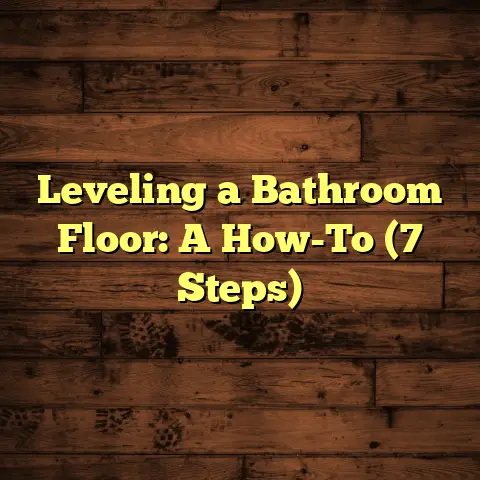Lifeproof Vinyl Flooring: Temperature Ranges To Consider? (Explained)
Did you know that extreme temperatures can cause vinyl flooring to expand or contract, potentially leading to damage?
This surprising fact caught my attention early in my career, and it’s something I’ve kept in mind ever since.
As a flooring contractor, I’ve had my fair share of experiences with Lifeproof vinyl flooring.
It’s a popular choice among homeowners due to its durability and aesthetic appeal.
However, understanding temperature ranges is key to ensuring that this material performs at its best.
Understanding Temperature Sensitivity of Lifeproof Vinyl Flooring
Lifeproof vinyl flooring is designed to withstand a variety of conditions, but it’s not invincible.
When I installed it in a home without considering the temperature ranges, I quickly learned that extreme heat and cold could lead to issues.
Installation Temperature Range
For optimal installation, I recommend maintaining a temperature range of 65°F to 85°F (18°C to 29°C).
If the space is colder than this, the vinyl can become rigid and harder to work with.
On the other hand, if it’s too hot, the adhesive properties might be compromised.
I remember one summer when I worked on a project in a home that was uncomfortably hot during the day due to poor air conditioning.
The flooring was difficult to lay down correctly because it kept buckling under the heat.
I had to wait until evening when temperatures cooled down, which made me realize how crucial it is to check the forecast before starting an installation.
Effects of Temperature on Vinyl Flooring
After installation, temperature fluctuations can still impact the vinyl.
Expansion and Contraction
Vinyl flooring can expand in high heat and contract in cold weather.
I once dealt with a job where the vinyl started buckling due to excessive heat from direct sunlight streaming through large windows.
The homeowner hadn’t considered using window treatments, and it resulted in an unsightly floor that we had to address later on.
To avoid these issues, I advise clients to:
- Use rugs or curtains to block direct sunlight.
- Maintain a consistent indoor temperature whenever possible.
You might wonder what happens if your vinyl floor does start to buckle or warp.
In my experience, the first step is to assess whether it’s due to temperature changes or moisture issues.
If it’s temperature-related, carefully lifting the affected areas and allowing them to acclimate can sometimes resolve the issue.
Humidity’s Role
Humidity is another factor that affects vinyl flooring.
In high humidity, the material can absorb moisture and swell.
On a job in a coastal area, the humidity was so high that it caused the flooring to lift in certain areas.
We had to remove and replace sections of the floor, which added unexpected costs and time delays.
I always encourage clients living in humid climates to invest in a good dehumidifier.
Setting it to maintain humidity levels below 50% can greatly reduce the risk of moisture-related problems.
Maintenance Tips for Temperature Management
Keeping your Lifeproof vinyl flooring in good condition involves regular maintenance and awareness of environmental factors.
- Regular Cleaning: Dust and dirt can scratch the surface, especially if trapped under furniture or rugs.
A simple sweep or vacuum every week can help maintain its appearance. - Temperature Control: Use dehumidifiers in humid climates and air conditioning or heating to regulate indoor temperatures.
This helps mitigate expansion and contraction issues. - Avoiding Heavy Furniture: It’s tempting to place heavy furniture on vinyl floors, but doing so can create dents or indentations.
Use furniture pads to distribute weight evenly. - Routine Inspections: Check for any signs of lifting or buckling regularly.
Catching these issues early can save you from costly repairs. - Preventive Measures for Extreme Weather: In areas with extreme winter temperatures, consider installing insulation under your flooring to help maintain a stable temperature.
Cost Estimation Made Easy with FloorTally
When it comes to cost estimation for projects involving Lifeproof vinyl flooring, FloorTally has been invaluable for me.
It pulls local material and labor rates effortlessly, allowing me to provide accurate estimates to my clients right from the beginning.
For instance, when I recently worked on a project involving 1,000 square feet of flooring, I was able to input all necessary details into FloorTally.
The platform calculated the costs associated with materials, labor, and even potential waste factors seamlessly.
This level of detail not only helps me create realistic budgets but also builds trust with my clients.
They appreciate knowing that there won’t be any hidden costs later on.
Common Challenges Faced
Despite its advantages, Lifeproof vinyl flooring does come with its own set of challenges.
- Scratching: While it’s marketed as scratch-resistant, I’ve noticed that heavy traffic areas can still show wear over time.
Using mats at entrances can help reduce this. - Installation Issues: As mentioned earlier, temperature plays a significant role in installation success.
Rushing through without considering conditions can lead to costly mistakes. - Limited Repair Options: If the floor gets damaged, repairing it isn’t as straightforward as it might be with hardwood or tile.
It often requires replacing entire planks rather than just fixing a section.
Comparing Lifeproof Vinyl Flooring with Other Options
When evaluating flooring options, I often compare Lifeproof vinyl with laminate and engineered hardwood.
Durability
Lifeproof vinyl is more resistant to moisture than laminate and engineered hardwood.
In areas prone to spills or humidity, like kitchens or bathrooms, it’s often my top recommendation.
Aesthetic Appeal
While laminate and engineered hardwood offer a natural look, Lifeproof has come a long way in mimicking these materials.
The print technology used creates stunning visuals that many homeowners love.
Cost
Generally speaking, Lifeproof tends to be more affordable than high-quality engineered hardwood but may be on par with premium laminate options.
In my experience, the choice often depends on the specific needs of the homeowner and their lifestyle.
Personal Anecdotes: Successes and Challenges
Throughout my career as a flooring contractor, I’ve encountered various scenarios that have shaped my understanding of Lifeproof vinyl flooring.
A Successful Installation
One of my most memorable projects was for a young couple who wanted new flooring throughout their home.
They chose Lifeproof vinyl because they had pets and young children—two factors that often lead homeowners toward durable options.
The installation went smoothly because we waited for ideal conditions—between 70°F and 75°F—and ensured proper acclimation before laying down the planks.
The result was stunning, and they were thrilled with how easy it was to clean up after their kids and pets.
A Challenging Experience
On another occasion, I worked with an older homeowner who wanted to replace her kitchen floor with Lifeproof vinyl.
However, her kitchen was located in a sun-drenched area that received direct sunlight for most of the day.
Despite my warnings about temperature management, she insisted on proceeding without window treatments initially.
Sure enough, after just a few weeks, we noticed some warping around the edges of the planks due to heat exposure.
We had to remove sections of the flooring and re-install them after she agreed to add blinds and keep her kitchen cooler.
This taught me how important it is to communicate potential pitfalls clearly with clients before installation begins.
Technical Specifications of Lifeproof Vinyl Flooring
Understanding the technical specifications of Lifeproof vinyl flooring can help homeowners make informed decisions about their purchases.
- Thickness: Most Lifeproof planks have a thickness ranging from 6mm to 8mm.
Thicker planks tend to be more durable and provide better sound insulation. - Wear Layer: One of the standout features is its wear layer, which usually measures around 20 mils thick (0.5mm).
This protects against scratches and scuffs. - Backing Layer: The backing layer adds comfort underfoot while providing stability against moisture intrusion.
- Installation Method: Lifeproof vinyl typically uses a click-lock installation method which is user-friendly even for DIY enthusiasts.
I’ve seen many homeowners successfully install it by themselves after following some basic instructions.
Installation Process: What You Need to Know
If you’re considering installing Lifeproof vinyl yourself, here’s what you need to do:
- Preparation: Start by removing any existing flooring and ensuring the subfloor is clean and dry.
A level subfloor is crucial for preventing future issues. - Acclimation: Let your new vinyl planks acclimate in the room where they will be installed for at least 48 hours before starting work.
- Tools Required: Gather your tools: utility knife, measuring tape, spacers, and tapping block are essential for a successful installation.
- Laying the Planks: Begin laying planks from one corner of the room while ensuring you leave an expansion gap around walls (usually about 1/4 inch).
- Final Touches: After all planks are laid down, you can install baseboards or quarter rounds for a polished look.
Practical Information About Usage and Maintenance
After installation comes maintenance—keeping your Lifeproof vinyl flooring looking great takes some effort, but it doesn’t have to be overwhelming.
- Cleaning Routine: Regular sweeping or vacuuming will help prevent dirt buildup.
For deeper cleaning, use a damp mop with gentle cleaners specifically designed for vinyl flooring. - Avoid Harsh Chemicals: Steer clear of abrasive cleaners or scrubbing pads that could scratch the surface.
- Address Spills Promptly: Wipe up spills quickly using warm water and a soft cloth.
Stains left unattended can become more challenging to remove over time. - Protect Against Furniture: In high-traffic areas or under heavy furniture pieces, consider using area rugs or floor protectors to prevent wear and tear.
Conclusion: Finding What Works Best for You
Choosing Lifeproof vinyl flooring requires careful consideration of temperature ranges and maintenance practices.
By being aware of potential challenges and applying practical tips from my experiences, you can ensure that your flooring looks great for years to come.
Remember, whether it’s managing temperature-related issues or maximizing budget accuracy with tools like FloorTally, informed decisions lead to successful outcomes in flooring projects.
Have you faced unique challenges with your flooring choices?
What solutions have you found effective?
Let’s share our experiences!





